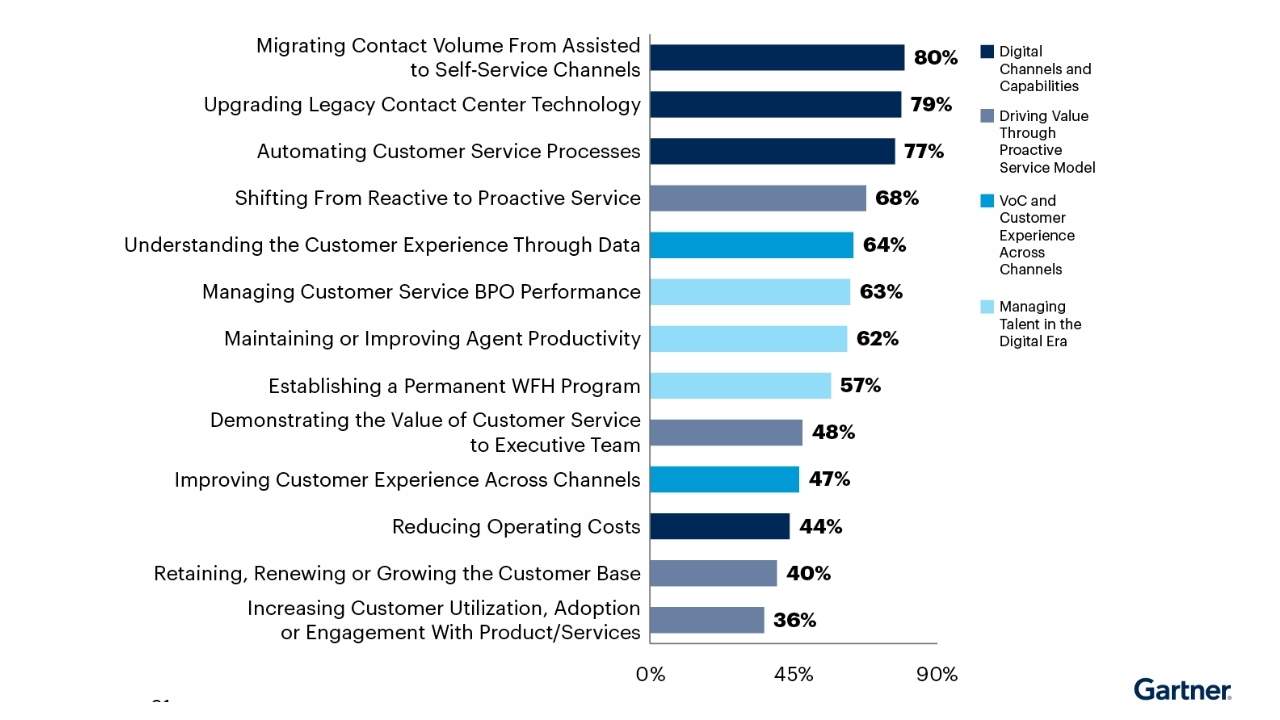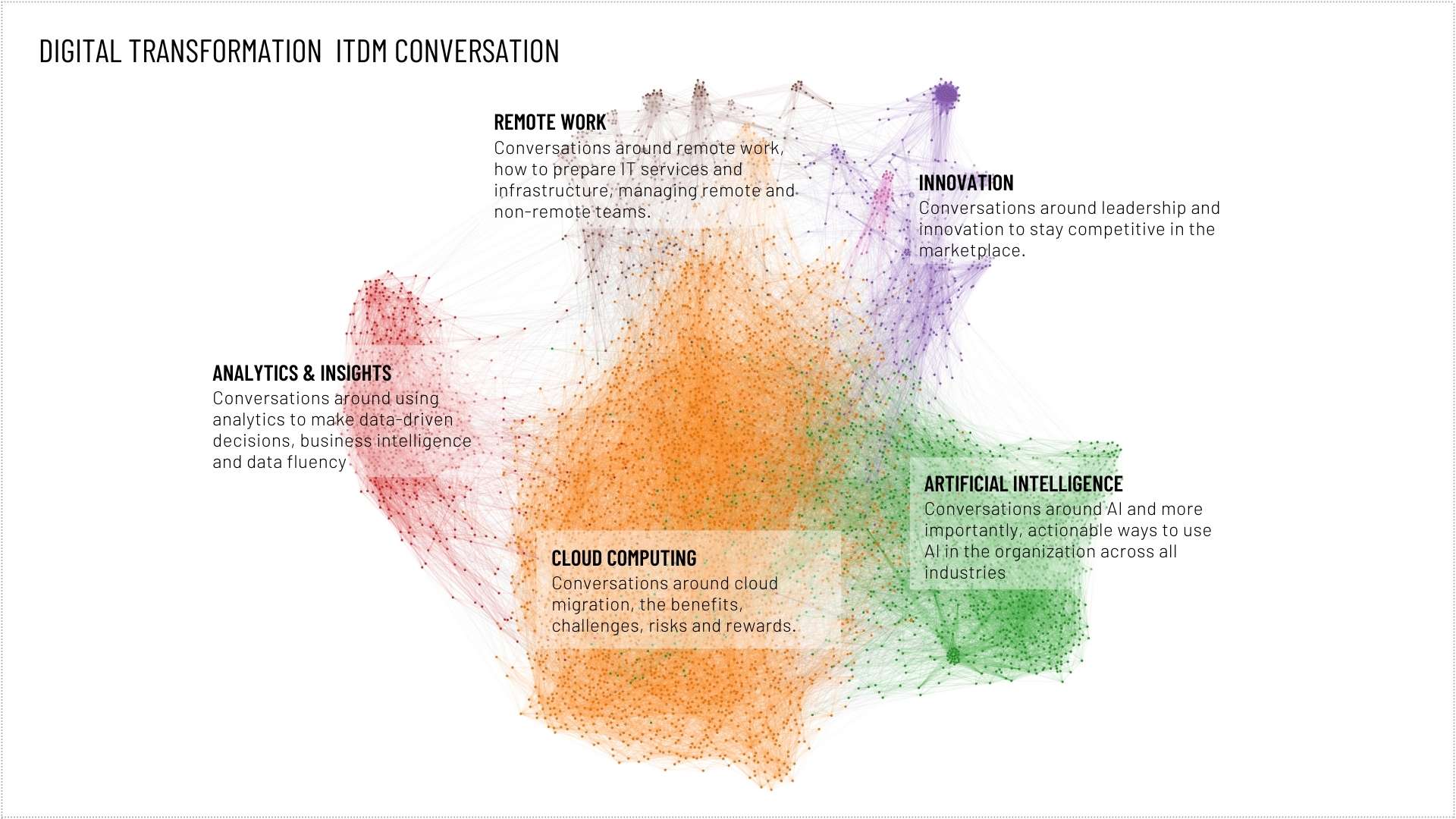Data is important. Context helps you understand why it’s important.
Why this matters:
Conversational analytics can be valuable for any brand looking to get deeper customer insights. By tracking and analyzing conversations, brands can identify trends, manage reputation, and truly understand the sentiment about their products and services.
Conversation analytics is 100% actionable and can be used in many ways by different stakeholders. Example insights can include the following:
- Executives can analyze conversations to gauge how their customers feel about the brand. This is often referred to as brand health.
- Digital marketing teams can learn more about customer pain points, trends, purchase intent, and conversational triggers that impact the customer journey.
- Paid search teams can extract data from just about any source and use it to inform the keywords they are bidding on for their search programs.
- PR teams can track conversation analytics for coverage insights. Conversational analytics analyzes text so that articles can be included.
- Support teams can analyze call center data to understand why customers need support using customer conversations or speech/language from an inbound phone call or phone calls.
- R&D teams can use conversation analysis to understand customers’ unmet needs and build more relevant products.
- Sales teams can use conversation analytics to understand what’s top of mind for business and IT decision-makers. Then, they can customize their approach to overcome objections and provide more relevant pitches and thought leadership content.
- Business decision-makers can use conversation analysis to read product reviews of software applications.
In 2021, Gartner surveyed 80 B2C and B2B business decision-makers who oversee the customer support function about their priorities for 2021. The responses ranged from migration to self-service customer support channels, upgrading the call center tech stack, and process automation.
These three priorities were classified as “Digital Channels and Capabilities” and were the top three most important in 2021 (see below). Coming in at a solid 5th place is understanding the customer experience through data, which falls into the “Voice of the Customer (VoC) and Customer Experience Across Channels” category.

Customer data can be interpreted and used in several different ways. This could be looking at the shopping cart abandoned rate on an e-commerce site or customer complaints from a retail store. Brands can also use conversation data from post-purchase surveys when conducting VoC analysis.
This type of analysis could be helpful when understanding why a customer buys a product, what they’re using it for, or what they plan to use it for. Finally, customer data can also be used for customer experience analytics.
What is Conversational Analytics?
Conversational analytics analyzes text from social media conversations to gain insights into customer sentiment, behavior, and preferences.
This data can come from various sources, including online forums, social media platforms, customer reviews, and survey responses. By analyzing this data, brands can better understand how their customers feel about their products and services, what they’re looking for in a purchase, and what factors influence their decision-making.
The data can also be pulled from news articles, which can help power a media landscape analysis.
Additionally, conversation analytics can help brands identify trends and patterns in customer behavior, which can be used to improve marketing and sales strategies. Conversation analytics is a powerful tool to help businesses gain insights into customers’ needs and wants.
Text Analysis is Synonymous With Conversation Analytics
Text analysis is extracting meaning from words and conversations (text) to make informed decisions. It can find trends, identify customer sentiment, or discover new ideas and hidden insights.
Text analysis converts unstructured text data into structured data for deep analysis. The most common methods for doing this are artificial intelligence (AI) and natural language processing (NLP). AI can automatically identify patterns in text, while NLP can be used to extract specific information from it. Both AI and NLP are essential for performing text analysis at scale.
Text analysis is used in various applications, such as sentiment analysis, topic identification, and named entity recognition.
- Sentiment analysis can automatically identify the sentiment and emotion of the text. This is often used to assess customer satisfaction or track brand health.
- Topics identification is automatically extracting the main topics from the text. This can be used to understand what a customer is talking about, identify new product ideas, or track industry trends.
- Named entity recognition automatically identifies named entities in text, such as people, places, organizations, and products. This can be used to find out who is talking about a brand, where they are located, or what products they are interested in.
Conversation analytics is a subset type of text analytics that focuses on understanding customer interactions. Text analytics and conversation analytics are two sides of the same coin – both are essential tools for understanding customer behavior and making informed decisions.
Conversational Analytics: Use Cases and Examples
There are many different use cases for conversational analytics. For example, you can use it to analyze social media conversations, contact center transcripts, product reviews, or media coverage. Ultimately, conversation analysis can provide valuable insights that help you improve the customer experience.
Social media conversations are the most common source for conversation analytics, hence “conversational.” It involves collecting social media mentions to analyze the meaning and context behind the conversation. Then, the conversations can be extracted through social listening or scraping technology and uploaded to a text analysis tool. Many social listening platforms have text analytics capabilities.
Contact center transcripts: Contact center transcripts are another common source for conversational analytics. This data can be used to understand customer sentiment, identify support issues, or track customer satisfaction over time. The data can be extracted through speech-to-text technology and then uploaded to a text analysis tool for further analysis.
Product reviews: You can also use conversation analytics to analyze product reviews. This can be used to understand customer sentiment, identify product issues, or get ideas for product innovation. The data can be extracted through web scraping technology and uploaded to a text analysis tool.
Company reviews: You can also use conversational analytics to analyze company and product reviews. This can be used to understand employee sentiment, identify company issues, or understand the ratings of the company CEO. The data can be extracted through web scraping technology and uploaded to a text analysis tool.
Customer feedback: Another use case for conversational analytics is to analyze customer feedback. This can be used to understand customer sentiment, identify support issues, or track customer satisfaction over time. The data can be collected through surveys, chatbots and forms, contact center transcripts, and uploaded to a text analysis tool.
Media coverage: Another use case for conversation analytics is media coverage. This can be used to understand how the media perceives your company, product, or brand and uncover hidden narratives about an industry. Sadly, most media monitoring platforms do not provide this level of sophistication. Instead, they only offer volume, impressions, and links to articles.
The net of this is that conversational analytics can be used for various use cases. The data sources are also varied, but the most commons are social media conversations, contact center transcripts, and product reviews. Text analysis is always the first step of all conversational analytics.
Types of Conversation Analytics Software
A variety of conversation analytics software platforms are available on the market today. Each platform offers unique features and benefits, making it essential for businesses to select the right tool for their needs. When investing in the right tool, the one common denominator is finding one with artificial intelligence (AI) and NLP.
- Social Listening. Many social listening platforms like Infegy, Netbase Quid, and Brandwatch have built-in conversation analytics capabilities. These platforms allow you to collect social media insights and then analyze them for insights.
- Text Analytics Tools. Several text analytics tools offer conversational analytics, such as IBM Watson, Google Cloud Natural Language API, and Graphext. These platforms provide more advanced features and functionality than social listening platforms, making them ideal for brands that need more sophisticated analysis.
- Call Center Analytics Platforms. In addition to social listening and text analytics platforms, call center platforms offer conversational analytics capabilities. These platforms allow you to collect and analyze call center data for insights. The most popular call center analytics platforms are CallMiner and Verint.
One of the most popular text analytics platforms is IBM Watson Explorer. This platform provides businesses with several powerful features, including automatically analyzing text data, identifying customer sentiment, and tracking customer interactions across channels.
Conversation Data Reigns Supreme
To fully understand conversation data, you need to understand the definition of a conversation. Merriam-Webster defines a conversation as “an informal talk involving two people or a small group of people.”
In this context, conversation data is acquired from conversations happening online. This could be anything from the time and date of the conversation, the location, the people involved, and the actual content. Businesses and organizations must consider what they hope to learn or gain from it to properly collect and analyze conversation data. With that in mind, they can set up systems for recording and storing the data and analyzing it in a way that will be most helpful for marketing and social media teams.
Conversational Marketing + Social Media
Conversations are what drive human behavior. They can influence others, build relationships, and create memorable experiences between friends, families, colleagues, and industry peers. It doesn’t matter if those conversations happen in person or on social media.
Smart, data-driven marketers use conversational marketing by mining social media mentions to understand customer conversations’ “true context.” Doing so helps them create more personalized human experiences for their customers and prospects.
This is where conversational analytics comes in. Businesses and organizations can gain a wealth of insights that can be used for PR intelligence, improve customer experience, drive sales, and improve marketing efforts by analyzing social media conversations.
What’s the Future of Conversation Analytics?
As the world becomes increasingly digitized, so does how we communicate. As a result, more and more businesses are using conversation analytics to gain insights into customer behavior and trends. Real-time listening allows companies to track and analyze customer conversations as they happen, while predictive analytics uses past data to identify future trends.
Conversation analytics is still in its early stages, but the potential applications are endless. In the future, brands can start using conversation analytics to provide better customer service, understand how customers interact with their products, and make better marketing decisions. In addition, conversation analytics will help businesses identify emerging markets and opportunities for growth. As technology continues to evolve and wants to become more human, it will become an essential tool for businesses of all sizes.
Example of Conversation Analytics
Below is an example of conversation and text analysis of digital transformation. The data was extracted from a predefined audience of IT decision-makers.
You’ll notice the large clusters of language representing the sub-set of topics and themes related to digital transformation.

While this is just an example, you can see how analyzing text data can uncover narratives and themes that aren’t in plain sight.
